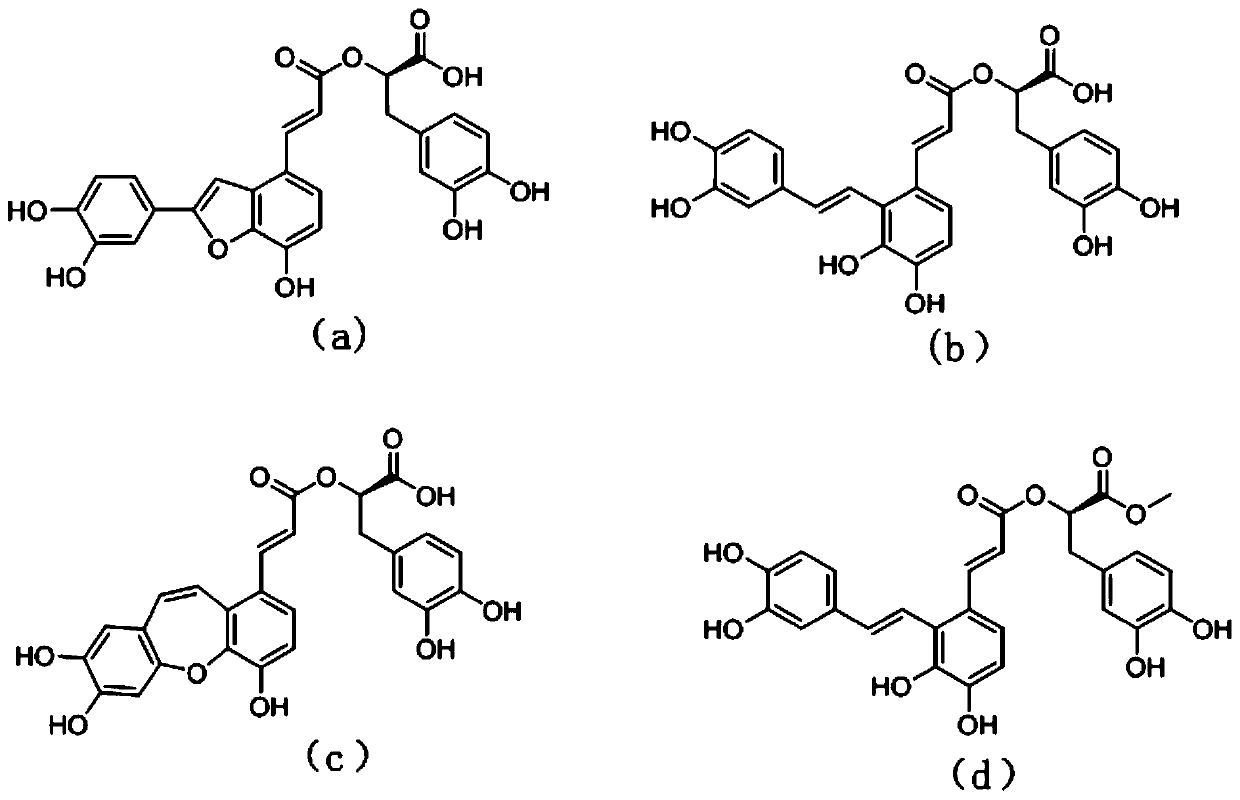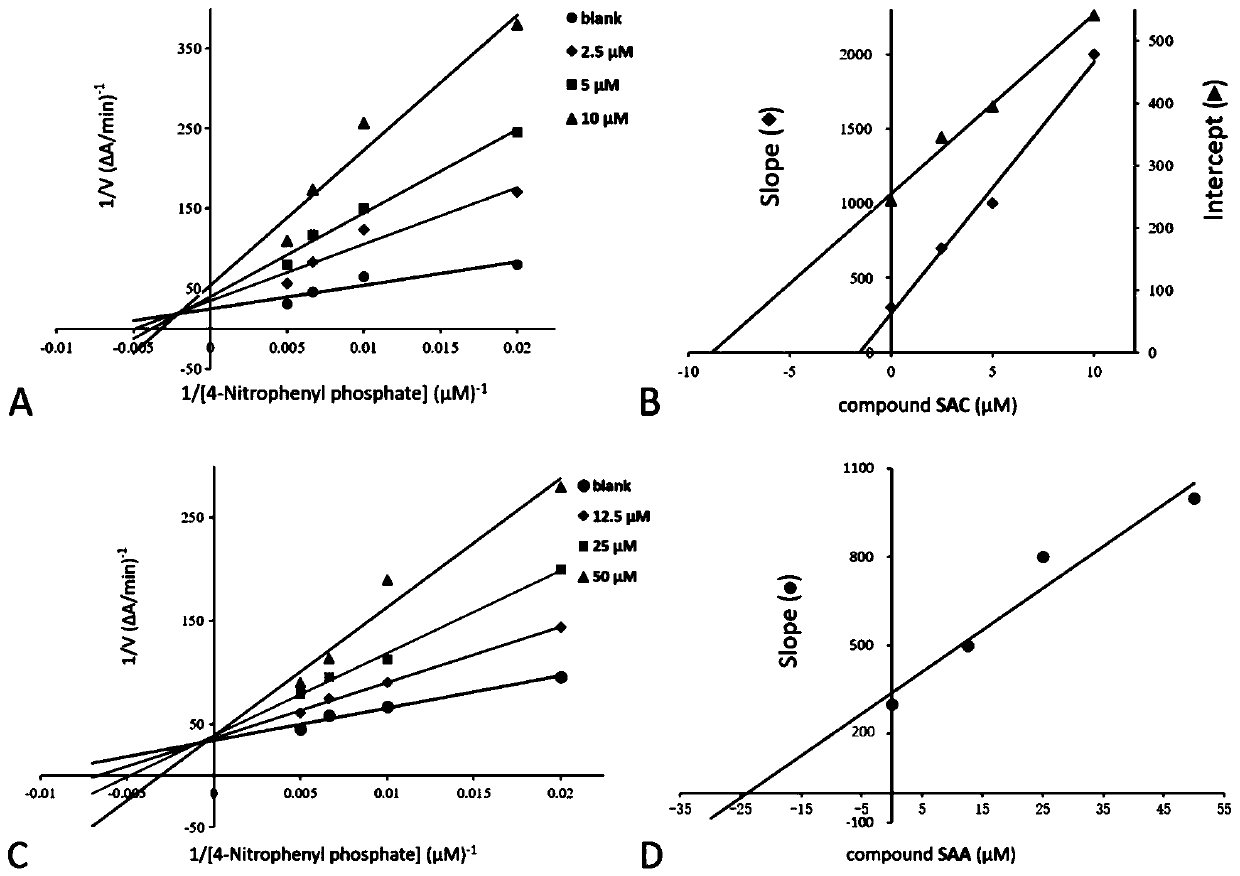Application of salvia miltiorrhiza extracts in preparing protein tyrosine phosphatase 1B inhibitor and drug for preventing and/or treating type 2 diabetes
A technology of tyrosine phosphatase and type 2 diabetes, which is applied in the field of medicine and can solve problems such as insufficient research
- Summary
- Abstract
- Description
- Claims
- Application Information
AI Technical Summary
Problems solved by technology
Method used
Image
Examples
Embodiment 1
[0030] Example 1 Evaluation of inhibitory activity of compound salvianolic acid C, salvianolic acid A, isosalvianolic acid C or salvianolic acid A methyl ester on PTP1B
[0031] The PTP1B inhibitory activity of compounds salvianolic acid C, salvianolic acid A, isosalvianolic acid C or salvianolic acid A methyl ester was evaluated by in vitro enzymatic experiments.
[0032] 1.1 Preparation of reagents and standard solutions
[0033] (1) 75mM phosphate buffer (PB, pH 7.4): Weigh KH 2PO 4 0.0956g, K 2 HPO 4 0.6946g, EDTA1.862mg, dissolved with ultrapure water and diluted to 50mL. Freshly prepared before each experiment, used to dissolve diluted samples and other reagents;
[0034] (2) PTP1B solution: Accurately weigh an appropriate amount of PTP1B, dissolve it with 75mM PB solution and prepare a 10U / mL PTP1B working solution, blow the enzyme solution with a pipette, and store it on ice until use;
[0035] (3) Substrate preparation: Accurately weigh an appropriate amount o...
Embodiment 2
[0046] Example 2 Compounds Salvianolic Acid C and Salvianolic Acid A Determination of Inhibition Kinetics of PTP1B
[0047] In vitro enzyme kinetic experiments were used to determine the inhibitory activity of compounds salvianolic acid C and salvianolic acid A on PTP1B.
[0048] 1.1 Preparation of reagents and standard solutions
[0049] (1) 75mM phosphate buffer (PB, pH 7.4): Weigh KH 2 PO 4 0.0956g,K 2 HPO 4 0.6946g, EDTA1.862mg, dissolved with ultrapure water and diluted to 50mL. Freshly prepared before each experiment, used to dissolve diluted samples and other reagents;
[0050] (2) PTP1B solution: Accurately weigh an appropriate amount of PTP1B, dissolve it with 75mM PB solution and prepare a 10U / mL PTP1B working solution, blow the enzyme solution with a pipette, and store it on ice until use;
[0051] (3) Substrate preparation: Accurately weigh an appropriate amount of 4-Nitrophenyl-phosphate (p-NPP), add 75mM PB solution to dissolve, and prepare a substrate wo...
Embodiment 3
[0059] Example 3 Compounds Salvianolic Acid C and Salvianolic Acid A Determination of Inhibitory Reversibility of PTP1B
[0060] 1.1 Experimental steps
[0061] (1) Add 100 μL of the sample solution to be tested at different concentrations on a 96-well plate, then add 50 μL of PTP1B solution at different concentrations (0.1-0.5 U / mL), and use the same volume of PB as the blank control group, and each group is parallel Set up 3 replicate holes. Place the enzyme system on a microplate reader at 37°C and incubate for 10 min, read once at a wavelength of 405 nm, and record the absorbance value.
[0062] (2) Subsequently, 50 μL of substrate p-Nitrophenyl phosphate (p-NPP) (0.5 mM) was added to the enzyme system to start the enzyme reaction system, read at a wavelength of 405 nm every 30 s for a total of 10 min, and record the absorbance value.
[0063] (3) Data processing: use MS Excel 2013 and Graphpad Prism v6.0 to comprehensively analyze and process the experimental data obtai...
PUM
 Login to View More
Login to View More Abstract
Description
Claims
Application Information
 Login to View More
Login to View More - R&D
- Intellectual Property
- Life Sciences
- Materials
- Tech Scout
- Unparalleled Data Quality
- Higher Quality Content
- 60% Fewer Hallucinations
Browse by: Latest US Patents, China's latest patents, Technical Efficacy Thesaurus, Application Domain, Technology Topic, Popular Technical Reports.
© 2025 PatSnap. All rights reserved.Legal|Privacy policy|Modern Slavery Act Transparency Statement|Sitemap|About US| Contact US: help@patsnap.com



